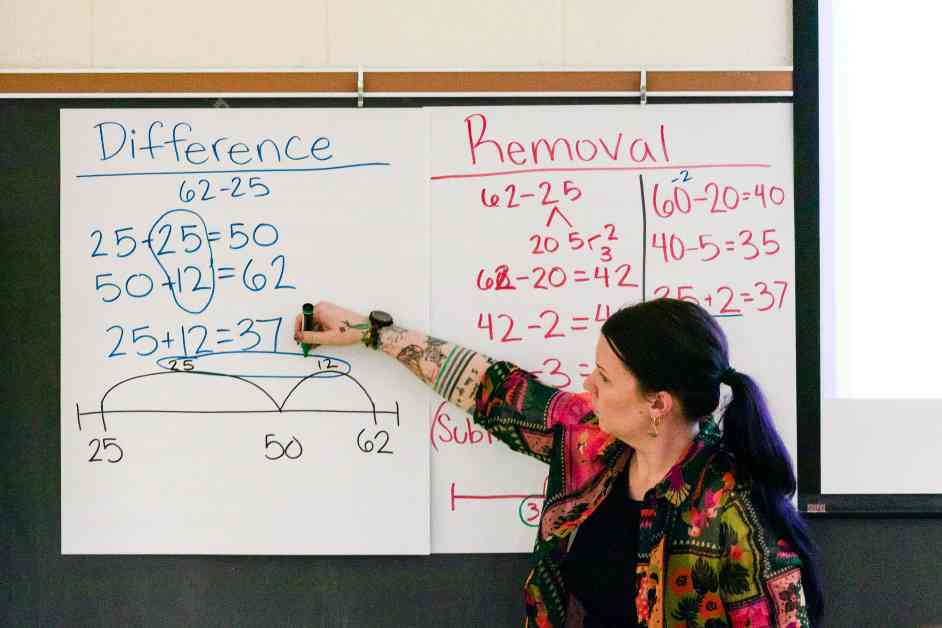Reviving Traditional Math Teaching Methods in Early Grades in Milwaukee
In a bustling classroom on a sweltering June afternoon, a group of dedicated kindergarten through second-grade teachers gathered at Milwaukee’s North Division High School. Despite the faulty air conditioning, the teachers were engrossed in a math lesson led by Danielle Robinson and Alicia Socha, two educators in the district. The lesson posed a simple problem: “I went to the store to buy some fruit. I bought five apples and four bananas. How many pieces of fruit did I buy?” The teachers quickly solved the problem, but the focus was not on the answer. Instead, they delved into the type of problem it was, dissecting and describing it to gain a deeper understanding of how to teach it effectively to their young students.
Teaching foundational math concepts such as counting and basic arithmetic may seem straightforward, but for early-childhood and elementary teachers, it involves introducing abstract ideas like the meaning of numbers, comparisons, and fractions. The challenge lies in helping students grasp these concepts and apply them in a meaningful way. Beth Schefelker and Claire Madden, math education specialists, led another group of teachers and principals in exploring fractions. With the district’s investment of nearly a million dollars in Covid-19 relief funds for professional development, educators were given the opportunity to enhance their math teaching skills and strategies.
Many teachers who participated in these sessions never considered themselves “math people,” but as they engaged in hands-on activities and discussions, they discovered a newfound enjoyment and understanding of math. Kayla Thuemler, a first-grade teacher, experimented with using a number line to visualize fractions, a method she had never encountered before. By seeing fractions with different denominators represented on the same number line, she gained a more coherent understanding of fractions as a connected system. This shift in perspective was pivotal in helping teachers build confidence in their math instruction.
Melissa Hedges, the math curriculum director for Milwaukee schools, and DeAnn Huinker, a renowned math education professor, observed the teachers’ progress with pride as they witnessed a renewed excitement for math among the educators. Huinker, who spearheaded a math education revolution in the district between 2004 and 2014, emphasized the importance of continuous learning for teachers to enhance student learning outcomes. She believed that when teachers are engaged in professional development, students benefit from improved instruction and understanding.
Huinker’s vision for transforming math instruction in Milwaukee began with a partnership between the University of Wisconsin-Milwaukee and the local school district, funded by a $20 million grant from the National Science Foundation. The Milwaukee Mathematics Partnership aimed to elevate math teaching practices by providing teachers with specialized training and ongoing support. Through this initiative, 120 math teacher leaders were appointed to facilitate collaboration between university experts and classroom teachers, ensuring a cohesive and effective approach to math education.
Despite initial challenges and resistance from some district administrators, the Milwaukee Mathematics Partnership gained momentum and garnered national recognition for its innovative teaching methods and collaborative efforts. By aligning teaching practices with state standards, developing standardized assessments, and fostering a culture of continuous improvement, the partnership achieved significant gains in student achievement and teacher satisfaction. The emphasis on conceptual understanding in math instruction, rather than rote memorization, proved to be transformative for both educators and students.
As the partnership flourished, test scores in math showed improvement, with some schools experiencing substantial gains in proficiency levels. However, the impact of the partnership extended beyond test scores, influencing grades, student interest in math, and teacher morale. The structured accountability framework established by Huinker and her team ensured that resources were allocated effectively to support math instruction, leading to sustained progress over the years.
Despite the success of the Milwaukee Mathematics Partnership, the initiative came to an abrupt end in 2014, following a change in district leadership and priorities. The decision to terminate the partnership left many educators disheartened, as they saw the valuable impact it had on math instruction and student learning. In the years that followed, standardized test scores in math fluctuated, highlighting the challenges of sustaining educational reforms in a complex and evolving educational landscape.
Today, Milwaukee Public Schools faces new challenges in implementing a revised math curriculum while navigating budget constraints and leadership transitions. The legacy of the Milwaukee Mathematics Partnership lives on through the dedication of educators like Danielle Robinson, who continue to uphold the principles of effective math instruction and collaborative learning. Despite setbacks and obstacles, educators remain committed to providing high-quality math education to students and fostering a culture of continuous improvement in teaching practices.
As Milwaukee Public Schools grapple with the ongoing evolution of math instruction, the lessons learned from the Milwaukee Mathematics Partnership serve as a beacon of hope and inspiration for educators striving to make a difference in students’ lives. By reviving traditional math teaching methods and emphasizing conceptual understanding, teachers in Milwaukee are paving the way for a new generation of math learners who are empowered to think critically, problem-solve, and succeed in mathematics and beyond.



